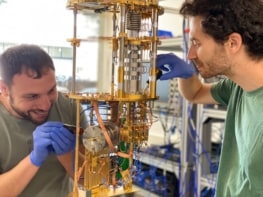
A new optical technique that is very efficient at distinguishing between molecules that are mirror images of each other could have major applications in areas such as drug development, biochemistry and toxicology. Being able to differentiate between such molecules is critical in these areas because the different mirror-image forms, or enantiomers, often produce very different effects in the body.
At present, the main way to distinguish between enantiomers is by sending circularly-polarized light through a sample. Molecules of one “handedness”, or chirality, will absorb more such light than their mirror image, producing a tell-tale difference in the transmitted light. This circular dichroism (CD) method is routinely employed in analytical chemistry, biochemistry and in the pharmaceutical, cosmetic and food industries. Its chief drawback is that the signals produced are very weak, and the sample ideally needs to be in the gas phase. This can be a problem for chemistry and biochemistry experiments that are mainly carried out in aqueous solutions.
Helical rather than circular dichroism
The new method, developed by researchers at Switzerland’s Paul Scherrer Institute, the École polytechnique fédérale de Lausanne (EPFL) and the University of Geneva, overcomes these problems because it works using a form of dichroism, helical dichroism (HD), that involves the shape of light (that is, its wavefront) rather than its polarization.
“One can imagine an optical vortex as a light beam, where the wavefront is twisted like a screw along the propagation direction,” says team leader Jérémy Rouxel, who is now at the Université de Saint-Etienne in France. “Just like a screw, the direction of this wavefront can go in one direction or another, comparable to a left- and a right-handed thread.”
Unlike in CD, which is strongly limited by the fact that light can only be left- or right-polarized, HD has the advantage that optical vortices can twist multiple times within one wavelength of the used light. This can enhance the dichroic signal strongly and can also be used to determine the degree of chirality of a molecule.
Distinguishing between enantiomers
In their study, Rouxel and colleagues used helical X-ray light from the cSAXS beamline at the Swiss Light Source to study a powdered form of a chiral metal complex called iron-tris-bipyridine. This compound absorbs and scatters light with left and right helical vortices differently, Rouxel explains.
“The central point here was to create X-ray optical vortices for the experiment, and to measure the difference in X-ray absorption with the various possible vortices,” Rouxel tells Physics World. “We did this using a special diffractive optical element called a spiral Fresnel zone plate. With this lens, it is possible to focus the light onto a sample and to generate the optical vortex at the same time.”

‘Cartwheeling’ light reveals new type of polarized light-matter interaction
The team’s experiments showed that the signal derived from HD was several orders of magnitude stronger than that possible from CD. The researchers are now studying other molecules to improve the reliability of the technique and, in Rouxel’s words, “establish it for the community”.
“We also plan to implement it for more liquid samples, which will make HD even more interesting for chemistry research,” Rouxel reveals. “Finally, we have to study more extensively how the dichroism varies as a function of the threading degree.”
The work is detailed in Nature Photonics.



